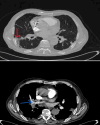Managing Complex Pacemaker-Associated Endocarditis With Thromboembolism in Tbilisi, Georgia: A Case Report
- PMID: 40255766
- PMCID: PMC12006781
- DOI: 10.7759/cureus.80804
Managing Complex Pacemaker-Associated Endocarditis With Thromboembolism in Tbilisi, Georgia: A Case Report
Abstract
Cardiac implantable electronic devices (CIEDs), including permanent pacemakers, implantable cardioverter-defibrillators (ICDs), and cardiac resynchronization therapy (CRT) devices, have become crucial in managing cardiac arrhythmias and heart failure. However, despite advancements in implantation techniques and prophylactic measures, CIED-related infections, including infective endocarditis (IE), remain a significant clinical challenge. These infections contribute to considerable morbidity and mortality, often requiring prolonged hospitalization, complex interventions, and significant healthcare costs. CIED-IE is particularly concerning due to its association with systemic complications, including septic embolization, which increases the risk of adverse outcomes. We report the case of a 77-year-old male with a history of permanent pacemaker implantation who developed pacemaker-associated infective endocarditis complicated by septic pulmonary embolism. The patient experienced recurrent febrile episodes over a year and was intermittently treated with antibiotics without a definitive diagnosis. He later presented with fever, dyspnea, and generalized fatigue, prompting further investigation. Transesophageal echocardiography (TEE) revealed vegetation measuring 1.39 × 2.75 cm on the pacemaker lead, and pulmonary CT confirmed bilateral septic emboli, indicative of septic embolization. Two sets of blood cultures were positive for methicillin-sensitive Staphylococcus aureus (MSSA) within 12 hours. Given the high risk of complications, a multidisciplinary team, including cardiologists, infectious disease specialists, and cardiothoracic surgeons, assessed embolic risks, infection control, and pacing needs. Broad-spectrum intravenous antibiotics and anticoagulation therapy were initiated. Despite medical management, the persistent infection and embolic risk necessitated transvenous lead extraction (TLE), which was performed under general anesthesia. A temporary pacing lead was inserted due to the patient's pacemaker dependence. The procedure was successfully performed without complications, and no residual vegetations were observed on follow-up imaging.
Keywords: pacemaker infection; pacemaker lead extraction; pulmonary embol; staph aureus endocarditis; subacute bacterial endocarditis.
Copyright © 2025, Rekvava et al.
Conflict of interest statement
Human subjects: Consent for treatment and open access publication was obtained or waived by all participants in this study. American Hospital Tbilisi ethics comitee issued approval AHT-2025-015. This study was reviewed and approved by the Ethics Committee/Institutional Review Board of American Hospital Tbilisi, ensuring compliance with ethical guidelines for research involving human subjects. Informed consent was obtained from all participants as per the IRB's recommendations. . Conflicts of interest: In compliance with the ICMJE uniform disclosure form, all authors declare the following: Payment/services info: All authors have declared that no financial support was received from any organization for the submitted work. Financial relationships: All authors have declared that they have no financial relationships at present or within the previous three years with any organizations that might have an interest in the submitted work. Other relationships: All authors have declared that there are no other relationships or activities that could appear to have influenced the submitted work.
Figures




References
-
- The emergence of Staphylococcus aureus as the primary cause of cardiac device-related infective endocarditis. Urien JM, Camus C, Leclercq C, et al. Infection. 2021;49:999–1006. - PubMed
-
- Infective endocarditis in patients with cardiac implantable electronic devices: a nationwide study. Mateos Gaitán R, Boix-Palop L, Muñoz García P, et al. Europace. 2020;22:1062–1070. - PubMed
Publication types
LinkOut - more resources
Full Text Sources
Research Materials
